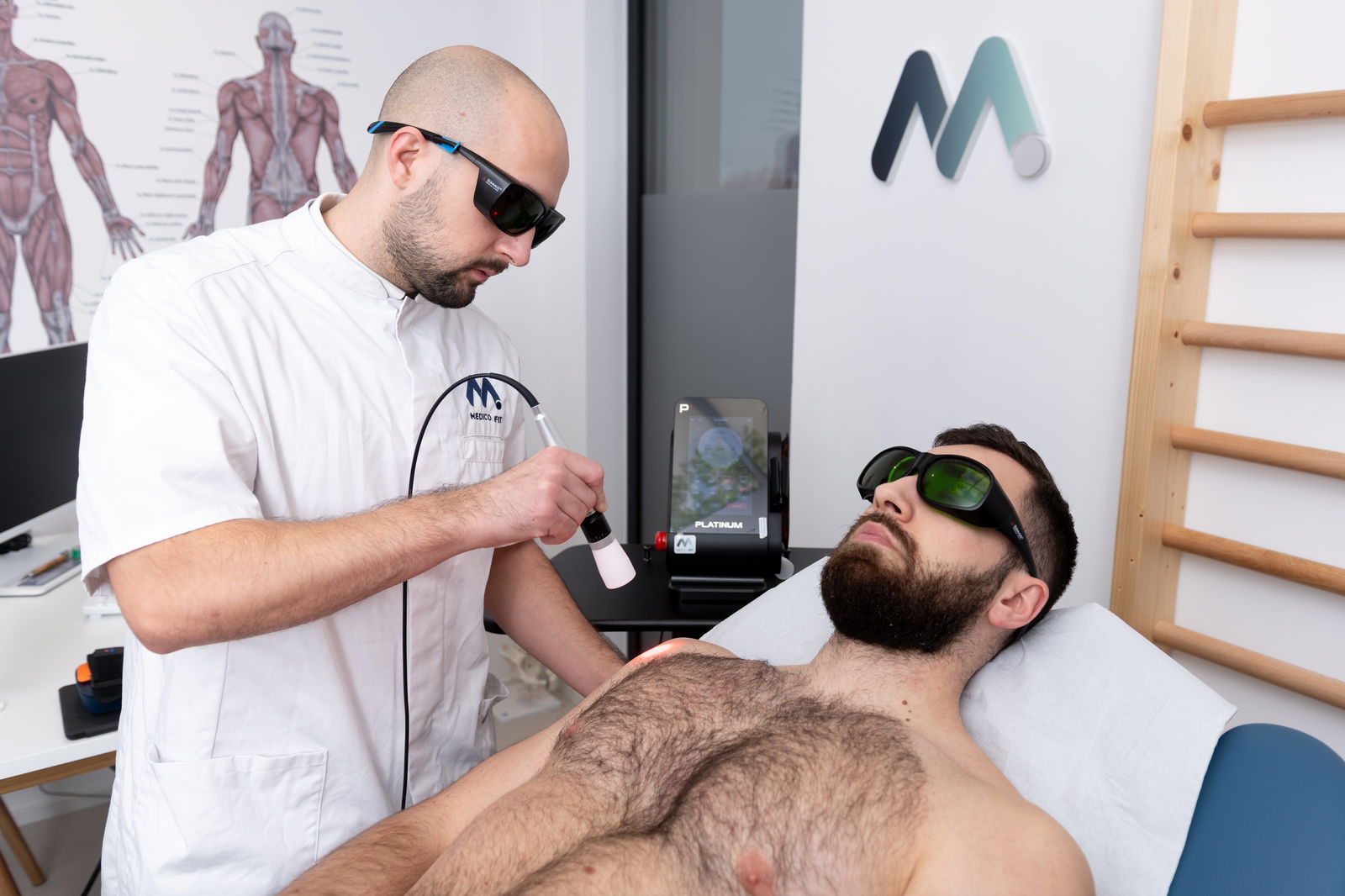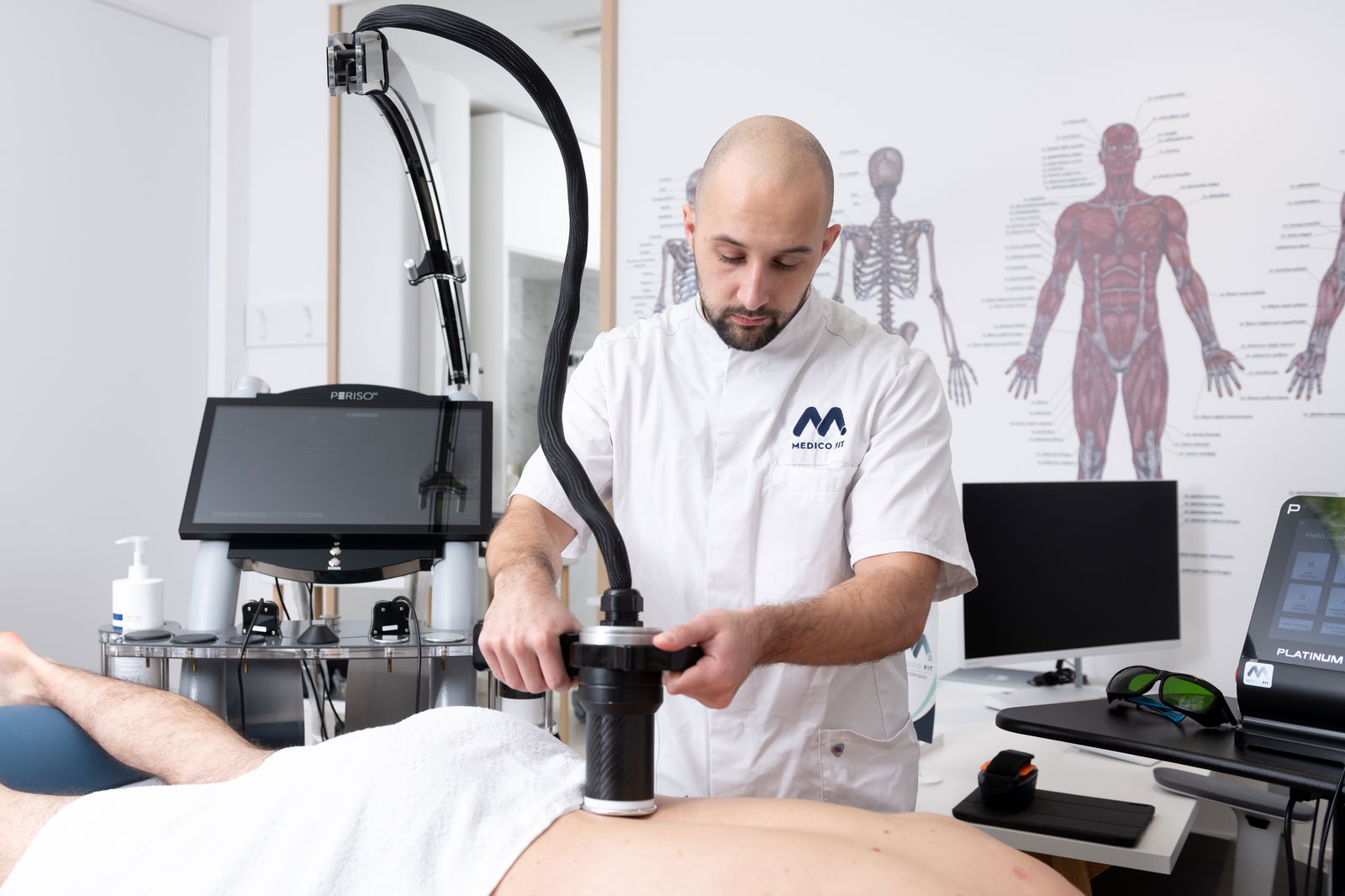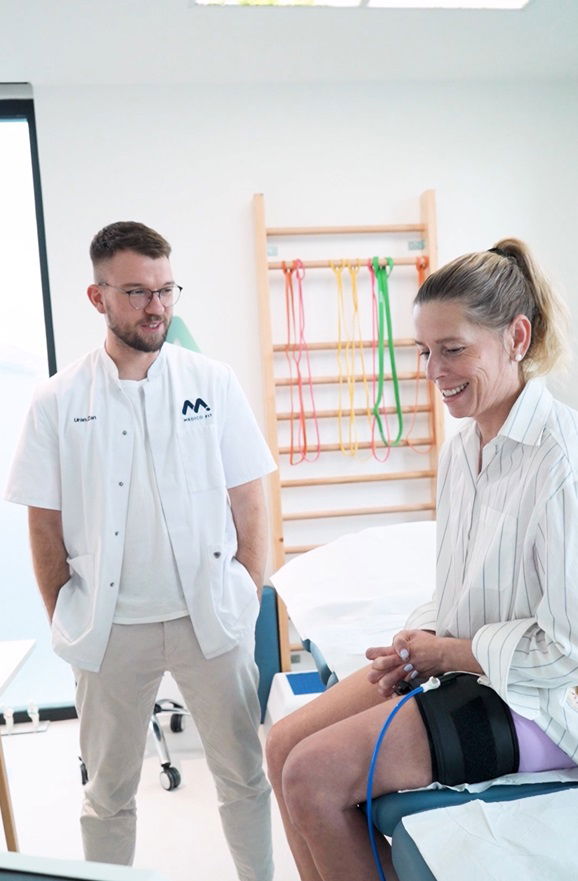More importantly, patients understand why they hold most of the responsibility for successfully resolving musculoskeletal problems by choosing the right physiotherapy treatment. If you are dealing with a musculoskeletal disease or injury, you will most likely find yourself in the following situation today.
Relatively good diagnostic results, a noticeable lack of accurate treatment instructions from medical staff, and extremely general or unadapted physiotherapy, which will not be sufficient for ultimately successful rehabilitation.
The current reality for most orthopaedic patients is such a markedly ineffective physiotherapy that it leaves them in despair after several episodes of unsuccessful treatment. It is very likely that the physiotherapy staff will not be familiar with many of the specifics of your symptoms and the diagnostic data on your reports.
All of these are characteristics of physiotherapy as a general physical form of treatment, which, at least in Slovenia, developed from the roots of public healthcare in the form we know today.
However, in recent years modern physiotherapy has undergone a technological and scientific renaissance towards specialised treatment and is already becoming accessible to patients in Slovenia.
General physiotherapy in clinical practice means that the therapist is primarily trained in the use of physiotherapy techniques without in-depth knowledge of the specialisation of the entire treatment process for a particular pathology.
A general physiotherapist only knows various techniques as therapeutic tools that are performed routinely with each patient with the aim of ensuring potential positive effects.
Due to general physiotherapy, which is not specifically tailored to the pathology that is the source of the patient’s symptoms, treatment is often ineffective or the effects are extremely short-lived.
As a result, patients do not know they should do, and the risk of surgical treatment is also greatly increased.
The goal of general physiotherapy is always short-term, specifically to relieve the current pain. Therefore, it is not an effective long-term solution for patients.
Specialist physiotherapy means that, in addition to having good knowledge of physiotherapy techniques, the therapist is educated in the pathophysiology and treatment process of specific pathologies that are the cause of the problems.
There are quite a few orthopaedic conditions for which there are already clear guidelines for specialist physiotherapy. We know of approximately 30 to 50 different causes of pain or injuries for each of the seven joint areas in the body.
Specialist physiotherapy cannot be compared to general physiotherapy in any way. It is a rehabilitation process based on advanced expertise, designed from the very beginning for a specific background of problems affecting the patient.
The treatment has a precisely prescribed regimen of therapies and instrumental technology, and begins with in-depth physiotherapeutic diagnostics.
The goal of specialist physiotherapy is always long-term, specifically to restore full motor function to the patient with a high level of preventive resilience.
Book a specialist physiotherapy appointment

Why did we write this article?
In this article, MEDICOFIT physiotherapy specialists present the main differences between general and specialist physiotherapy in the treatment of musculoskeletal injuries and diseases.
Patients facing more or less complex problems will learn about the latest findings in physiotherapy, which means they will better understand when specialist physiotherapy is indicated.
We believe that this article will help answer why physiotherapy in the past was not effective and restore confidence in physiotherapy itself, which has excellent treatment effects and is today the priority choice before surgery for an increasing number of diseases and injuries, when planned using correct specialist techniques.
If you were born after 1965, there is a 90% chance that you will experience severe back pain at least once in your life. By 2024, 50% of people will experience at least one form of arthritis, and 70% of the elderly already report intense chronic joint pain.
Understanding physiotherapy is therefore key to a healthy future and a high quality of our lives.
What is the main difference between general and specialist physiotherapy?
The main difference between general and specialist physiotherapy is basically the adaptation of therapies for a specific pathology and not simply performing a treatment for an individual joint or anatomical region.
Although at first glance this may seem obvious to the layman, they will in 92% of cases undergo treatment with general physiotherapy, which is still the dominant and standard form of physiotherapy in our country. The chances of successful rehabilitation are low in such a case, and actually minimal for complex conditions.
General physiotherapy is easiest for the patient to understand as the physiotherapist focusing on the therapeutic techniques for general pain reduction.
Specialist physiotherapy is most easily understood as the physiotherapist focusing on the patient’s pathology as the source of their problems and specialising the entire therapy process accordingly.
General physiotherapy is seen in treatment on prescription and in most private providers that we will find online. The main reason for this situation is the history of physiotherapy in Slovenia, which has primarily been shifted to private practice by experts from various branches of public healthcare.
For the patient, this means that they will also find similar treatment protocols in most private practices.
In general physiotherapy, the physiotherapist will focus primarily on the anatomical area, i.e. the affected joint, and will treat the symptoms themselves more from the perspective of reducing general joint pain.
Such treatment is characterised by more or less routine physiotherapeutic techniques according to a protocol, which can only have general beneficial effects for patients.

How is the modern science of physiotherapy developing?
Clinical research in the field of physiotherapy has advanced significantly in recent years. Today, we already have well-researched therapeutic procedures not only for the specific type of joint, but we also know of more than 210 different pathological conditions for which special therapeutic techniques have been prescribed, which are regularly improved and developed.
Nowadays, we have specialist fields within orthopaedic physiotherapy that give us clear guidelines for tailored treatment based on the cause of the pain or type of injury.
In most cases, this is a practice that stems from renowned international research institutes and centres for physiotherapy treatment, which means that, at least for now, MEDICOFIT clinic is the first and only physiotherapy provider that builds its network of specialised treatments on implementing best modern practices in regularly provided physiotherapy for patients.
How does the duration of treatment differ between general and specialist physiotherapy?
The purpose of general physiotherapy is to relieve pain or provide a quick solution, the so-called “quick fix”, where the primary goal is acute relief of the affected area.
Related content: Why do most physiotherapies not work? The pitfalls of “quick” physiotherapy
Such treatment is extremely short, the number of prescribed physiotherapy treatments is usually between three and ten sessions. It is a narrowly focused therapy aimed only at superficial pain reduction.
In physiotherapy on a work order basis, we will most often see the “conveyor belt” principle, where patients are prescribed the same number of therapy sessions with standard routine treatment.
General therapy will be short and the same for all patients, often concentrated, for example, once a day for a period of less than 14 days, which does not achieve the proven necessary break between therapy sessions.
The difference in treatment on a work order basis will also be in the waiting period for the patient, specifically according to the level of urgency, but unfortunately state authorities have also extended this period to 30 days even in cases of extreme urgency.
In the article The importance of waiting period we discuss, from a scientific perspective, the consequences of waiting too long for physiotherapy and the progressive increase in problems that begin after just three days in patients who have the highest need for treatment from a professional perspective.
Duration of treatment with specialist physiotherapy?
Specialist physiotherapy is always longer than general physiotherapy, the amount of prescribed therapy sessions is greater, and rehabilitation takes longer.
The regimen of therapies is predetermined according to the specifications needed to treat a particular condition. The number of treatments ranges from 20 to 30 therapy sessions for most conditions that do not involve postoperative treatment or complex chronic problems.
Specialist physiotherapy includes a wider range of advanced technology and a greater number of different manual techniques.
The kinesiotherapy performed will be arranged in sensible stages of increasing load, which take into account the actual rules of anatomical adaptation to load. The treatment process itself will usually have a smaller number of therapy sessions, for example two or three per week, and the treatment will span a period of 10 to 15 weeks.
Of course, we treat numerous postoperative conditions, rheumatic diseases, and progressive chronic diseases where the treatment timeline is longer and more specific.
Long-term solution for the patient
Specialist physiotherapy does not seek superficial quick fixes; most long-term results are achieved in the late phase of rehabilitation by increasing the load-bearing capacity of the affected area and building preventive resilience.
If the patient has extensive compensatory patterns and muscle asymmetries that are the result of a traumatic condition or chronic disease, then rehabilitation will be longer.
Book a specialist physiotherapy appointment

What is the goal of general physiotherapy?
The goal of general physiotherapy is always limited to reducing pain. It is not about eliminating pain, as this term is used in specialist physiotherapy, where we want to eliminate pain in the long term.
The primary goal of general physiotherapy is to reduce pain in the shortest possible time. General physiotherapy is a distinctly acute treatment of problems with limited effects.
What is the goal of specialist physiotherapy?
The goal of specialist physiotherapy is to restore full motor function to the patient.
Reducing pain is therefore only the first phase of rehabilitation; once it is achieved, the most demanding part of physiotherapy begins, where the patient is gradually returned to full and safe loading of the area with preventive resilience.
What is the biggest advantage of specialist physiotherapy for the patient?
It is a scientifically supported physiotherapy, which means it is an extremely well-researched process. If a specific technique does not have proven positive effects, it will not be used.
The exceptions are some rare diseases where we do not yet have clinical research, where we proceed from the known beneficial effects of the technology we use. Specialist physiotherapy methods have been tested many times, and are updated and improved very frequently.
Modern technology for pain relief and acceleration of healing is being upgraded almost every year with numerous new protocols. These are hard-learned skill or selected technologies with advanced effects for the target pathology we are treating.
Patient treatment is truly high-quality and always optimised for maximum effect.
The assessment methods used to monitor patient progress are extremely accurate as they monitor numerous parameters, not just the current intensity of pain, which is often an unreliable parameter when monitoring the success of treatment.
How accessible is specialist physiotherapy to patients?
Certain specialist physiotherapy techniques were previously inaccessible to patients unless they made a long journey abroad. An important goal of MEDICOFIT clinic was to establish an umbrella centre for orthopaedic physiotherapy where patients would have the opportunity to be treated with the most advanced specialist physiotherapy practices.
The problem with access to specialist physiotherapy also lies in the information provided to patients by medical professionals, who still rely excessively on prescriptions, where patients only receive general physiotherapy.
It is also a common mistake to advise patients to rest, while in reality the current guideline is early, tailored pain relief therapy to reduce the patient’s functional impairment.

What is the biggest disadvantage of general physiotherapy for the patient?
It is an experimental approach to physiotherapy. It is common to use whatever tools are available at the moment to reduce pain, usually without structure, proven therapeutic modalities, or strategically prescribed treatment specifications.
The patient’s response to such treatment can be extremely negative, with worsening symptoms, and even more often, such therapy simply has no effect.
In the case of a quick positive response to pain reduction, the problem of the patient’s dependence on quick solutions is established, which means that their pathological picture will very likely progress, and the patient will address episodes of pain with cyclical “quick” physiotherapy.
General physiotherapy can thus lead a patient from an innocuous injury to a more serious chronic disease and degenerative disorder, when the pain no longer subsides after some point.
Book a specialist physiotherapy appointment

How important is kinesiotherapy and what are the differences between general and specialist physiotherapy?
An important difference between general and specialist physiotherapy also lies in kinesiotherapy.
In general physiotherapy treatment, it is common practice to prescribe a narrow spectrum of the same exercises in a largely identical training regimen to virtually all patients.
A relevant illustrative example is a patient who has problems with the lumbar spine. General physiotherapy will prescribe a routine exercise system to the patient without adjusting the number of sets, load, repetitions, exercise variation, and any minor changes in the positions of body segments.
We must not forget that even a generally good exercise can have a markedly negative impact on the patient due to their numerous anatomical features.
Specialist physiotherapy will accurately measure the load-bearing capacity of the spine in all planes of motion (flexion, extension, rotation, lateroflexion) for such a patient and prescribe a kinesiotherapy regimen that will be specific, appropriately graded, and targeted at the desired tissue adaptation.
The set of exercises used to prescribe kinesiotherapy will basically include many more options for choosing exercise variations.
What are the differences in the intensity of physiotherapy?
A more obvious problem with general physiotherapy is the too low intensity of physiotherapy when the patient reaches the pain reduction phase.
Unfortunately, patients are too often instructed to perform exercises independently, which fundamentally represents a flawed rehabilitation principle, where there is no supervision over the patient’s response to the exercises and no appropriate escalation of the volume load.
Kinesiotherapy, as a phase of a patient’s rehabilitation, must be extremely well planned in terms of the exercises used and the intensity escalation.
Because the patient’s response to the exercise itself is unpredictable and often varies from therapy to therapy, it is important that rehabilitation is carefully managed under the supervision of a physiotherapy specialist, who will modify the exercises for each therapy session.
When routinely recommending home exercises, the rehabilitation scenario usually develops towards a negative patient response with worsening of the condition due to the complexity of the pathology itself, or towards insufficient exercise intensity, which leads to insufficient long-term joint resistance and a greater likelihood of injury recurrence.
What does a patient need to know about their understanding of physiotherapy and proper treatment?
A patient without adequate information generally does not have enough knowledge to make specific decisions in the context of physiotherapy treatment itself, so it is important, before starting any treatment, that the patient obtains the opinion or assessment of a physiotherapy specialist with expertise in rehabilitation procedures.
At MEDICOFIT clinic, as part of diagnostic therapy, we inform the patient about the natural course of their problem or disease, while at the same time obtaining a broad picture of their pathological condition.
Together with the patient, we define the key expert guidelines of specialist physiotherapy for their condition and prescribe an appropriate rehabilitation plan that is acceptable to the patient and meets scientifically proven standards of physiotherapy treatment for their condition.
In practice, patients are too often advised to rest by medical professionals or are “forced” to undergo general treatment that will not meet the patient’s needs to reduce their problems. The patient should also be wary of private providers who offer only one therapy method as a solution.
We are talking about the phenomenon that for a person with a hammer, every patient will represent a nail. From the private provider’s perspective, this is an understandable economic position; but from the patient’s perspective, it has potentially catastrophic long-term effects.
Why are patients increasingly choosing physiotherapy at MEDICOFIT clinic?
Modern physiotherapy must be primarily focused on treatment of movement, i.e. restoring full motor function. It is important that the treatment provider has the ability to provide the patient with specialised physiotherapy techniques for their disease or injury.
It is also crucial for modern physiotherapy clinics to be able to provide patients with long-term support in the form of individualised kinesiotherapy or therapeutic training, which ensures that they maintain optimal function.
For certain diseases and injuries, a long-term individualised support programme makes sense from a professional perspective.
Many progressive chronic or age-related diseases are most effectively treated with long-term, regular physiotherapy.
At MEDICOFIT clinic, we not only guide the patient to an asymptomatic state of pain, but also enable them to regain full motor function.
After successfully completing treatment, we additionally provide patients with long-term treatment within the framework of individualised kinesiotherapy, which meets the need for specialised preventive training that is recommended after numerous injuries.
When preparing long-term kinesiotherapy after an injury, we consider the patient’s full entire previous medical history in our clinic and, based on the analysis, prescribe a highly individualised long-term maintenance programme that is most suitable for the patient.
Treatment at MEDICOFIT clinic is mainly chosen by patients who consider the quality of rehabilitation important or who prioritise the permanent success of their treatment. These are often patients who value the comprehensiveness of the rehabilitation process and the individual approach in physiotherapy, and who also understand the long-term aspects of their own movement health.
Book a specialist physiotherapy appointment
Many patients who decide to seek treatment at MEDICOFIT clinic do so because they are dissatisfied with the general physiotherapy treatment or the low effectiveness of the treatment they are currently receiving. Today, there is a positive trend that patients are increasingly choosing physiotherapy at MEDICOFIT clinic based on many recommendations from acquaintances and friends.
Patients today increasingly understand the point of specialised physiotherapy treatment and recognise the added value of organised physiotherapy treatment, which includes initial diagnostic therapy, appropriate pain reduction, restoration of movement, and the option of long-term participation in the form of targeted kinesiotherapy training.

















